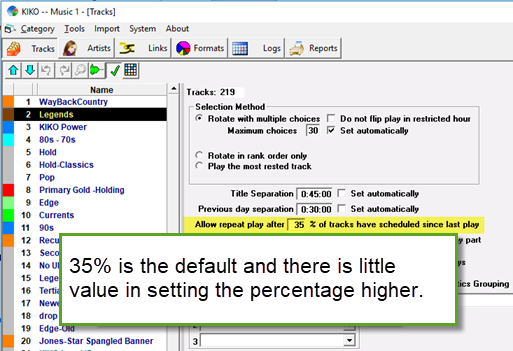This category rule doesn’t do what you think it does. It doesn’t improve song rotations nor efficiency. We created it as a balm for two specific scenarios. First, it prevents songs from scheduling again much too soon after a category shuffle. Second, it helps ensure that songs you might manually search-and-schedule won’t be scheduled by M1 close to that manually scheduled one.
On the first point, to help ensure that songs don’t come up too quickly after a shuffle, let’s say there is a category with 100 songs and the turnover is around 3 days. After saving a Monday schedule, we do the shuffle. Some of those songs that were scheduled Monday evening and were at the bottom of the card stack before the shuffle have now moved to the top of the card stack and are ready for re-scheduling right away in the overnight and morning hours of Tuesday instead of scheduling again 3 days later as would happen if there had been no shuffle. If we set the “allow repeat play after 35% of tracks have played….”, M1 will hold those late-Monday songs until 35% of the others in the category have scheduled. So, this being a 3-day turnover category, those late-Monday songs will get next-scheduled on Wednesday.
On the second point, if you manually search and schedule a song, you may want to have that play well separated from a ‘normal’ play scheduled by M1. For example, if a category is designed for all the songs in it to get 10 plays a week, and if you manually search and drop in one of the songs an extra time or two during the week, this rule helps prevent M1 from scheduling it again itself until 35% of the category has turned over since this one last played.
So, this is a helpful rule but not a critical one and changing it to a higher number won’t improve the day to day song rotations. Remember, M1 is designed to schedule every song in a category before repeating any of them.
